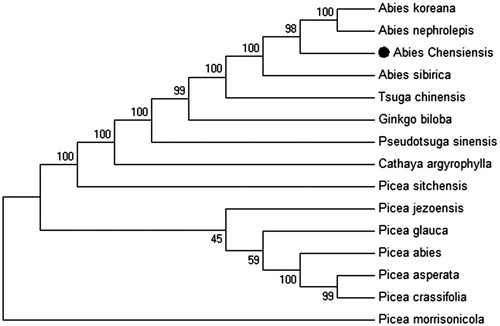Abstract
Chloroplast (cp) genome sequences became a widely used tool for evolutionary and phylogenetic studies in plants. Abies chensiensis (Pinaceae: Abietoideae) is an endangered species endemic to China. To understand its evolutionary characteristics, the complete chloroplast genome of the A. chensiensis has been reconstructed from the whole-genome Illumina sequencing data. The circular genome is 121,784 bp in length and without a typical quadripartite structure due to the loss of IR region. The total GC content of whole genome sequence is 38.3%. The chloroplast genome encodes 109 genes, including 75 protein-coding genes, 30 transfer RNA genes and four ribosomal RNA genes. Among them, 35 genes involved in photosynthesis, while 58 genes involved in self-replication. The Maximum-Likelihood phylogenetic analysis showed a strong sister relationship with A. nephrolepis and A. koreana in Abietoideae. Our findings provide fundamental information for further evolutionary and phylogenetic researches of Abietoideae.
Abies is an important genus of the Pinaceae family, and Abies chensiensis is endemic to China and has been listed as critically endangered species in China Plant Red Data Book as one of the II class conservation plants (Liu and Zhang Citation2003). Abies chensiensis distributed in Qinling and Bashan mountains with altitude from 1800–3500 m. Complete chloroplast genome sequences in Abies such as Abies koreana and Abies nephrolepis, have been reported (Yi et al. Citation2015; Yi et al. Citation2016). Therefore, sequencing and analysis of chloroplast genome structure of A. chensiensis will contribute to a better understanding of the evolutionary mode of the chloroplast genome and provide essential genomic information for protection of the critically endangered species.
The complete chloroplast genome of A. chensiensis is a circular DNA molecule with 121,784 bp in length and was deposited in GenBank with the accession number MH510244. The overall GC content of the cp genome is 38.3% GC content. Compared with other higher plants, chloroplast genomes of A. chensiensis has no typical quadripartite structure due to the loss of IR region, which is common in Abietoideae (Zhang et al. Citation2006). This chloroplast genome encodes 109 functional genes, including 75 protein-coding genes (PCGs), 30 tRNA genes and four rRNA genes. Among them, 35 are involved in photosynthesis, and 58 genes are involved in self replication. All genes are single copy while ycf12 and rps12 are double copy in genome. Moreover among all the protein-coding genes, three genes (atpF, rpl2 and rpoC1) have one intron, and gene ycf3 harbors two introns, while other 71 genes are intronless. Fifty-four genes locate in the forward strand and 55 genes locate in the reverse strand.
Fifty-seven conserved PCGs sequences from 14 chloroplast genomes were aligned by MAFFT (Katoh et al. Citation2002) and then were connected as gene strings. The Maximum-Likelihood phylogenetic tree of F. dibotrys was generated using those gene strings sequence by MEGA 6.0 (Tamura et al. Citation2013) with using 500 bootstrap replicates (). The Maximum-Likelihood phylogenetic analysis showed a strong sister relationship with A. nephrolepis and A. koreana in Abietoideae. Our findings provide fundamental information for further evolutionary and phylogenetic researches of Abietoideae.
Figure 1. Phylogenetic of 14 species based on the Maximum-Likelihood analysis of the whole chloroplast genome sequences using 500 bootstrap replicates. The analyzed species and corresponding Genbank accession numbers are as follows: Abies nephrolepis (KT834974.1), Abies koreana (KP742350.1), Abies sibirica (KR476376.1), Cathaya argyrophylla (AB547400.1), Ginkgo biloba (JN654343.1), Picea abies (HF937082.1), Picea asperata (KY204451.1), Picea crassifolia (KY204450.1), Picea glauca (KT634228.1), Picea jezoensis (KT337318.1), Picea morrisonicola (AB480556.1), Picea sitchensis (EU998739.3), Pseudotsuga sinensis (AB601120.1), Tsuga chinensis (LC095866.1).

Disclosure statement
No potential conflict of interest was reported by the authors.
Additional information
Funding
References
- Dierckxsens N, Mardulyn P, Smits G. 2016. NOVOPlasty: de novo assembly of organelle genomes from whole genome data. Nucleic Acids Res. 45:e18–e18.
- Doyle JJ. 1987. A rapid DNA isolation procedure for small quantities of fresh leaf tissue. Phytochem Bull. 19:11–15.
- Katoh K, Misawa K, Kuma K, et al. 2002. MAFFT: a novel method for rapid multiple sequence alignment based on fast Fourier transform. Nucleic Acids Res. 30:3059–3066.
- Liu SF, Zhang J. 2003. Fuping nature reserves biodiversity research and protection. Xi’an, China: Shaanxi Scientific and Technology Press.
- Tamura K, Stecher G, Peterson D, Filipski A, Kumar S. 2013. MEGA6: molecular evolutionary genetics analysis version 6.0. Mol Biol Evol. 30:2725–2729.
- Yi D-K, Choi K, Joo M, Yang JC, Mustafina FU, Han J-S, Son DC, Chang KS, Shin CH, Lee Y-M, et al. 2016. The complete chloroplast genome sequence of Abies nephrolepis (Pinaceae: Abietoideae). J Asia-Pac Biodivers. 9:245–249.
- Yi D-K, Yang JC, So S, Joo M, Kim D-K, Shin CH, Lee Y-M, Choi K. 2015. The complete plastid genome sequence of Abies koreana (Pinaceae: Abietoideae). Mitochondrial DNA. 2015:1–3.
- Zhang W, Xu X, Zhou J. 2006. Study on reproduction ecology of endangered species Abies chensiensis. Acta Ecologica Sinica. 26:2417–2424.
